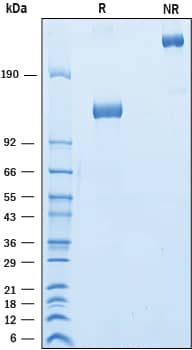Recombinant Cynomolgus Siglec-2/CD22 Fc Chimera Protein, CF
R&D Systems, part of Bio-Techne | Catalog # 10031-SL

Key Product Details
Source
HEK293
Accession #
Structure / Form
Disulfide-linked homodimer
Conjugate
Unconjugated
Applications
Bioactivity
Product Specifications
Source
Human embryonic kidney cell, HEK293-derived cynomolgus monkey Siglec-2/CD22 protein
| Cynomolgus Monkey Siglec-2/CD22 (Asp20-Arg687) Accession # EHH59463 |
IEGRMD | Human IgG1 (Pro100-Lys330) |
| N-terminus | C-terminus |
Purity
>95%, by SDS-PAGE visualized with Silver Staining and quantitative densitometry by Coomassie® Blue Staining.
Endotoxin Level
<0.10 EU per 1 μg of the protein by the LAL method.
N-terminal Sequence Analysis
Asp20
Predicted Molecular Mass
102 kDa
SDS-PAGE
115-134 kDa, reducing conditions
Activity
Measured by the ability of the immobilized protein to support the adhesion of human red blood cells. Kelm, S. et al. (1994) Current Biology 4:965.
The ED50 for this effect is 0.07-0.42 μg/mL.
The ED50 for this effect is 0.07-0.42 μg/mL.
Scientific Data Images for Recombinant Cynomolgus Siglec-2/CD22 Fc Chimera Protein, CF
Recombinant Cynomolgus Siglec-2/CD22 Fc Chimera Protein Bioactivity
Recombinant Cynomolgus Monkey Siglec‑2/CD22 Fc Chimera (Catalog # 10031-SL) supports the adhesion of human red blood cells. The ED50 for this effect is 0.07-0.42 ug/mL.Recombinant Cynomolgus Siglec-2/CD22 Fc Chimera Protein SDS-PAGE
2 μg/lane of Recombinant Cynomolgus Monkey Siglec‑2/CD22 Fc Chimera was resolved with SDS-PAGE under reducing (R) and non-reducing (NR) conditions and visualized by Coomassie® Blue staining, showing bands at 115-134 kDa and 230-270 kDa, respectively.Formulation, Preparation and Storage
10031-SL
| Formulation | Lyophilized from a 0.2 μm filtered solution in PBS with Trehalose. |
| Reconstitution | Reconstitute at 250 μg/mL in PBS. |
| Shipping | The product is shipped at ambient temperature. Upon receipt, store it immediately at the temperature recommended below. |
| Stability & Storage | Use a manual defrost freezer and avoid repeated freeze-thaw cycles.
|
Background: Siglec-2/CD22
References
- Varki, A. and T. Angata (2006) Glycobiology 16:1R.
- Crocker, P.R. et al. (2007) Nat. Rev. Immunol. 7:255.
- Wilson, G.L et al. (1991) J. Exp. Med. 173:137.
- Stamenkovic, I. and B. Seed (1990) Nature 345:74.
- Collins, B.E. et al. (2004) Proc. Natl. Acad. Sci. 101:6104.
- Engel, P. et al. (1995) J Exp Med. 181:1581
- Ravetch, J.V. and L.L. Lanier (2000) Science 290:84.
- Wienands, Y.J. et al. (1999) J. Biol. Chem. 274:18769.
Long Name
Sialic Acid Binding Ig-like Lectin 2
Alternate Names
BL-CAM, CD22, Siglec2
Gene Symbol
CD22
UniProt
Additional Siglec-2/CD22 Products
Product Documents for Recombinant Cynomolgus Siglec-2/CD22 Fc Chimera Protein, CF
Product Specific Notices for Recombinant Cynomolgus Siglec-2/CD22 Fc Chimera Protein, CF
For research use only
